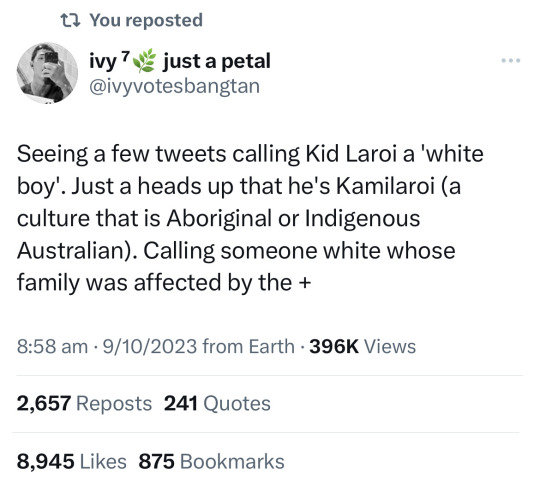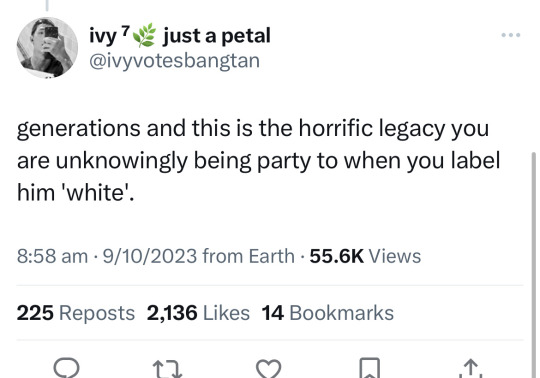#First Nation
Photo

Kent Monkman (Miss Chief Eagle Testickle)
Gender: Two spirit - genderfluid (he/him)
Sexuality: Queer
DOB: 13 November 1965
Ethnicity: First Nation (Cree)
Occupation: Artist, activist
#Kent Monkman#Miss Chief Eagle Testickle#qpoc#queerness#lgbtq#two spirit#genderfluid#non binary#queer#1965#first nation#poc#native#native american#artist#activist
262 notes
·
View notes
Text
LAND BACK IS LAND BACK
Turtle Island Indigenous (First Nation & Native Americans)
Latin America's
Palestine
Puerto Rico
Aboriginal Land
Aotearoa
Samoa
Hawai'i
Congo
Hong Kong
Yemen
(Please reblog with more places that in their right deserve their land back.)
#indigenous#First nation#Palestine#Puerto Rico#Aboriginal Land#Aotearoa#Samoa#Hawai'i#Congo#Hong Kong#Land Back#Free Congo#Free Palestine#stop cobalt mining#stop gaza genocide#Indigenous Land#feednorthgaza
76 notes
·
View notes
Text
Aspen, a 13-year-old two-spirit Ojibwe person from Thunder Bay, Ontario

Aspen writes over at CBC Kids News:
Hi, my name is Aspen Starr. I am from Biigtigong Nishnaabeg (Pic River First Nation). I am two-spirited and live in Thunder Bay, Ontario. Two-spirited for me, means that I carry both feminine and masculine spirits.
I first told my family that I preferred they/them pronouns when I was 11.
I was still figuring myself out, but knew I wasn’t a girl. I realized that I prefer they/them pronouns, but I was too scared to tell anyone.
Referring to someone using the correct pronouns is not only respecting who they are, but is also a way of showing allyship. Just standing by somebody and telling them that their feelings are valid can mean so much more to a young person than people realize.
For me, they/them pronouns make me feel like I’m free to be who I want to be.
Read the whole piece here.
Top photo: Aspen, centre, with two aunties, who have been their biggest supporters throughout their journey. They are also their best friends. (Image submitted by Deanna Starr to CBC)
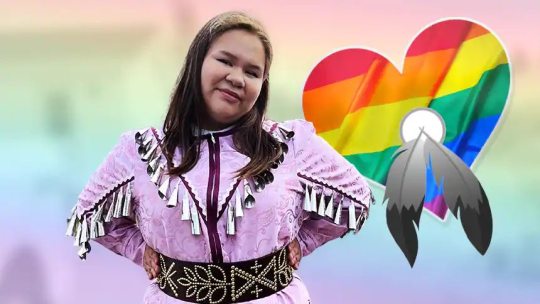
132 notes
·
View notes
Text

Still standing. 🪶🟧🟫💨
#first nations#american indian#native american#native people#native americans#First Nation#basquiat#peace pipe#standing rock#sioux city#sioux#crazy horse#sitting bull#Navajo#Apache#iroquois#lakota#south dakota#folk art#pow wow#teepee#water protectors#wounded knee#trail of tears#comanche#seminole#Foxwoods#red skins#mount rushmore#jean michel basquiat
15 notes
·
View notes
Text
Putting this here to not derail the other post, but that post about queer goyim using Jewish activism and teachings but not caring about Jewish people reminds me how I feel about some of the people who use 2Spirit without understanding what it means.
I see a lot of non-indigenous people use 2S in arguments about trans history, which is cool to me! I love having Indigenous history and culture recognized, especially pre-contact traditions and knowledge that highlights how different Indigenous is from Euro culture (atleast back then). But it leaves such a bad taste in my mouth when non-Indigenous people use it then don’t care and don’t listen to Indigenous people. This isn’t saying don’t use it in those arguments, I use it myself, but if you don’t care about Indigenous people and culture and don’t want to listen to us about it, don’t cherry pick it and misrepresent us and the term itself.
A misconception I see about 2 Spirit people is 1) applying it to all tribes. We are not a monolith, many tribes historically didn’t have 2 Spirit people, and there is a lot of diversity of the 2 Spirit people who did and do exist. The way each tribe views and interacts with gender is unique and deserves to exist on its own. The diversity of language families alone makes it impossible for the same words and meanings to be shared across all Indigenous people.
2) 2 Spirit is an umbrella term and doesn’t exclusively mean third gender/ multi-gender/ transgender. Those people are absolutely part of 2 Spirit, but 2 Spirit is an umbrella term, and a relatively new one at that (not a new concept however). 2 Spirit, simply put, means any pan-Indigenous identity that did not fit into the colonizers world and was tried to be erased through assimilation. This includes cis gay people. It was coined in the 1990 by the Inter-Tribal Native American Lesbian and Gay Conference to be a very broad, pan-Indigenous term that connects many First Nation people in a cultural way, sometimes even needing protection from other Indigenous people. A huge part of it has always been rejecting the Western binary of two genders, but spirituality and sexuality are an incredibly important part of it too.
#native#native american#indigenous#first nation#lgbtq+#indigenous history#indigenous culture#2s#2 spirit#trans#mine
56 notes
·
View notes
Text
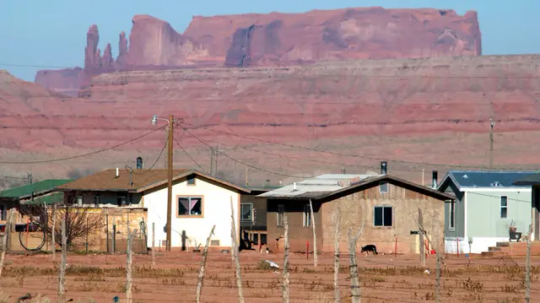
The Navajo Nation has received a $55 million grant to help Navajo homeowners with mortgage payments and home repairs.
Navajo Nation President Buu Nygren said as many as 901 homeowners should qualify for the funds.
The money comes from the American Rescue Plan Act, which provides nearly $10 billion to support homeowners throughout the country who face financial hardships due to the COVID-19 pandemic.
The program is open to Navajo homeowners of all income levels within the Four Corner states who live on both tribal lands and in urban areas.
The funds must be used within three years.

PHOENIX — Urban Navajos who own homes off the Navajo Nation will soon receive some unexpected help they’ll want but didn’t need to ask for.
On Sept. 11, Navajo Nation President Buu Nygren told 250 Phoenix metro area Navajo homeowners that the Nation received a $55 million federal grant to provide financial assistance to Navajo homeowners under various Homeowner Assistance Fund programs.
This includes mortgage payments and home repair assistance.
As many as 901 Navajo homeowners should qualify for the money for their homes, he said.
“Make sure we tell everybody,” Nygren told an overflow crowd in the shade outside the historic Phoenix Indian School Visitor Center, one of the remaining buildings from the 100-year-old Indian boarding school.
They were outside because a capacity crowd was already indoors awaiting the same announcement, and Nygren wanted to address those in the 105-degree F heat first.
The Homeowner Assistance Fund was authorized through the American Rescue Plan Act to provide $9.9 billion nationwide to support homeowners who face financial hardships associated with COVID-19, the Nygren said yesterday.
The funds were distributed to states, U.S. territories, and tribes. The Navajo Nation was awarded $55,420,097.
Most federally funded programs are restricted to low- and very-low-income households.
This program allows higher-income Navajo homeowners to receive financial relief from the economic effects of COVID-19, as well.
“Tell your relatives,” Nygren said. “Say the $55 million that came from our government was specifically for Navajo people who are homeowners.”
To launch the process, Nygren signed an agreement with Native Community Capital. The group is a Native-led and operated non-profit corporation that was selected as the sub-recipient to administer the Homeowner Assistance Fund Project activities on behalf of the Navajo Nation.
Native Community Capital is certified by the U.S. Department of the Treasury as a Native Community Development Financial Institution and is a licensed mortgage lender in Arizona and New Mexico.
The program is designed for both higher-income and medium-income homeowners, Native Community Capital CFO Todd Francis said.
As an example, a family of four in Maricopa County in Arizona earning as much as $132,450 a year may be eligible for the tax-free, non-repayable funds to pay their mortgage or repair their homes, he said.
The program will benefit Navajo relatives and their families who reside in both rural remote locations and those in the urban areas of Phoenix, Albuquerque, Denver, Salt Lake City, surrounding smaller cities and towns, and wherever Navajo homeowners live off-reservation, said NCC CEO Dave Castillo.
A significant lack of investment in tribal communities compared to non-Indian communities has resulted in a critical absence of homeownership on tribal lands, particularly for higher-income Native households, he said.
As a result, Navajos with higher incomes tend to purchase or build homes off the Navajo Nation where they can qualify for loans and mortgages to build equity and wealth.
The Center for Indian Country Development reports that 78% of Native people live outside of tribal trust land in counties surrounding their homelands. It is these families the HAF Project will seek to support, Castillo said.
Nygren said the Navajo HAF Project will provide financial assistance to 901 eligible Navajo homeowners to use for qualified expenses in five activities for the next 36 months.
The program will provide financial assistance to eligible Navajo homeowners in the four-state region of Arizona, New Mexico, Utah and Colorado.
Each eligible applicant could receive a maximum amount of $125,000 of combined assistance under various programs.
These include:
Monthly mortgage payment assistance to a maximum assistance level of $72,000 per participant. This is for Navajo homeowners who are delinquent in mortgage payments or at risk of foreclosure due to a loss of household income.
Mortgage reinstatement assistance would give a maximum assistance of $50,000 per participant to those who are in active forbearance, delinquency default status, or are at risk of losing a home.
Mortgage principal reduction assistance that would assist up to $100,000 for those who find the fair market value of their home is now less than the price they paid for it and now may result in a loss when it is sold.
Home repair assistance that would give $100,000 to those who need significant home repairs.
Clear title assistance of up to $30,000 for grant assistance to receive a clear title of their primary residence.
In his 2022 presidential campaign, Nygren committed to helping urban Navajos who have said for years that they felt underserved by the tribal government. He said this grant addresses that.
He said one of his administration’s next goals is to buy or construct a building owned by the Navajo Nation in the metro area to serve urban Navajo Phoenicians.
“Wouldn’t it be nice if we used the entire $55 million this year?” Nygren asked. “I know you committed to live here and to take care of your family. I see a lot of familiar faces and I understand this is where your jobs are. We want you to have access to resources.”
Castillo urged applicants to be sure their applications were complete and submitted early.
“One thing we want to emphasize is to be ready when the information is being requested on the checklist,” he said. “Make sure you have your documents prepared and you get it to our licensed professionals that will be working with you. If you do not, the application will expire in 30 days.”
He said the program has just three years to deploy the $55 million.
“It seems like we could do that quickly but we can only do it quickly if you help us, if you’re ready, and if you submit the information that’s necessary.”
Debbie Nez-Manuel, executive director of the Navajo Nation Division of Human Resources, said visits to other urban areas will be planned, scheduled, and announced by Native Community Capital.
The funds must be used within three years.
So does any of this money go to the Black Indians Tribes? @militantinremission
maybe y'all should start asking for your cut right now cause they got it
#Navajo#Navajo Nation#First Nation#Chief Buu Nygren#Nygren reveals $55 mil for Diné homeowners#HAF#The Center for Indian Country Development#Navajo Nation has received a $55 million grant to help Navajo homeowners with mortgage payments and home repair#@MilitantinRemission
15 notes
·
View notes
Photo
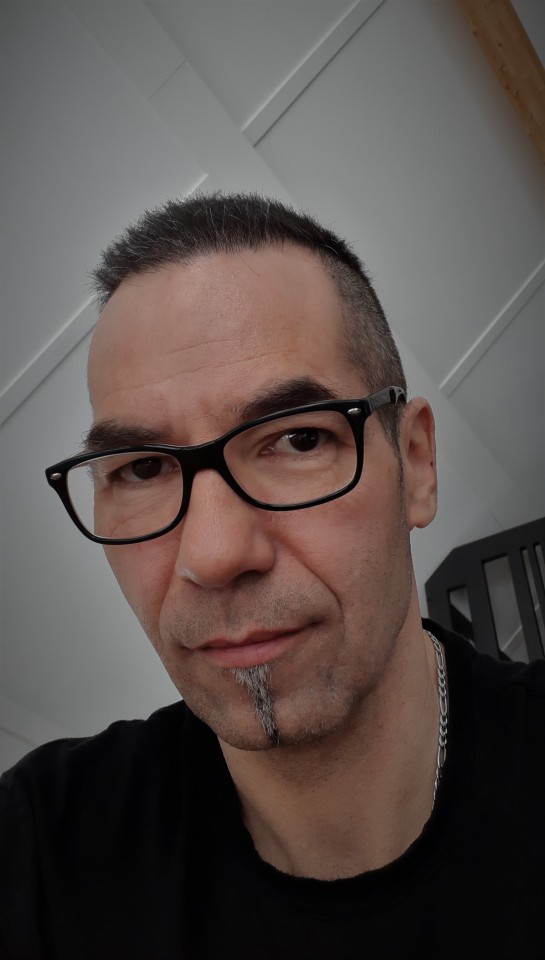
#IdleNoMore
... speaking of terms last evening with friends and a few others at the café Bistro, was very interesting. We stumbled on one specifically which is the "Indians" term that some people still use publicly toward the First Nations. We were laughing with each other saying that Native people are not coming from India and that this term was also widely regarded as old-fashioned and very inappropriate.
Indigenous people are most likely called, The Original (AbOriginal), Native people or as well as First Nations. But not erroneously referred as "Indians" like the first Europeans people when they mistakenly thought they had reached India in the fifteenth century. First Nations people have lived in the Northern Hemisphere for thousands of years and inhabited the area long enough before Europeans people "discovered" it.
(Absolutely no offense at all to the European's folks here)
Then starting to enumerate the most common North Faces groups in Canada: The Iroquois, Mohawk, The Cherokee, Sioux, Shawnee, Ojibwe, Light Skinned Cree (the largest indigenous tribe in Canada), Cheyenne, Mi'kmaq, among others.
To finally introduce myself to a few new friends in the café Bistro by saying; Hey btw, I'm Mohawk, but please call me Ben or Adrien. Cheers!
#Idle No More#First Nation#Indigenous People#Mohawk Community#Lifestyle#Native Land#Canada#The RavenKeeper
205 notes
·
View notes
Photo
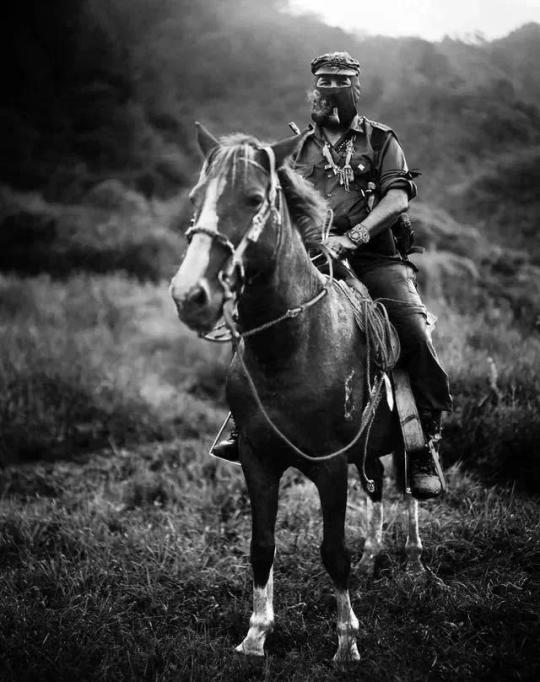
Subcomandante Marcos, the spokesman of the Ejército Zapatista de Liberación Nacional, striking a pose while smoking a pipe atop a horse in Chiapas, Mexico, 1996.
42 notes
·
View notes
Text
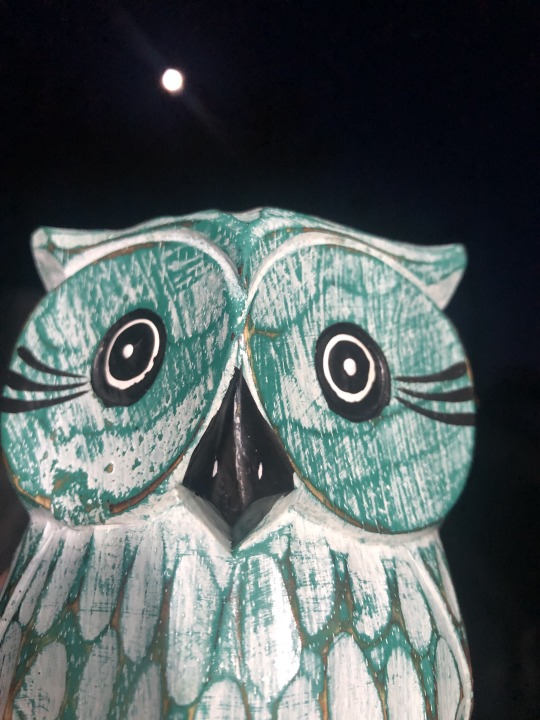
Lucky green owl I gifted to my mother, she took a photo of at night with a full moon in the background
ᐆᐦᐆ ôhô
2 notes
·
View notes
Photo
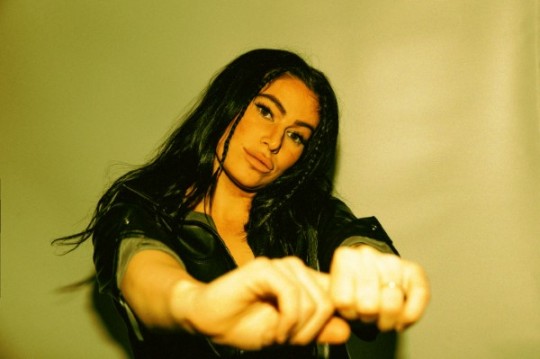
Shawnee Kish
Gender: Two Spirit (she/her)
Sexuality: Lesbian
DOB: N/A
Ethnicity: First Nation (Mohawk)
Nationality: Canadian
Occupation: Singer, songwriter
#Shawnee Kish#qpoc#bipoc#lgbtq#sapphic#two spirit#third gender#lesbian#first nation#native#native american#poc#canadian#singer#songwriter#popular#popular post
182 notes
·
View notes
Text
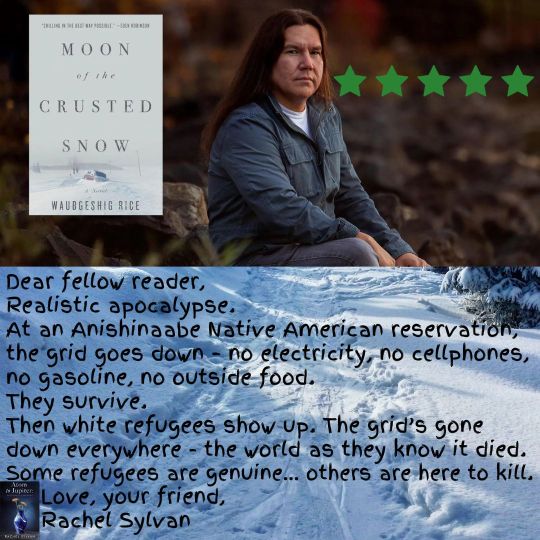
"Moon of the Crusted Snow" by Waubgeshig Rice book recommendation by Rachel Sylvan
2 notes
·
View notes
Text
Georgia - Singer-songwriter
Georgia is a South Sea Islander and Bundjalung woman based on the island of Minjerribah (North Stradbroke Island), Australia. She was raised with the good things she holds dear - love, music and the salt water. Georgia’s musical style could best be described as relaxed, soulful and heartfelt. It is a reflection of her strongest memories in her upbringing - learning to play guitar and piano by ear, singing together with family always in 3 part harmony and feeling the expression of the heart through music and song.
Georgia is fortunate to have performed internationally and nationally with a handful of the best in the industry some of them are Xavier Rudd, Emma Donovan, Deline Briscoe, Katie Noonan and David Bridie. She graduated from Performing Arts College, Brisbane in 2008 and since has been dancing, acting but mostly singing either as a solo artist, duo’s and bands.
Instrumentation: Vocals, Guitar
Music Genre: Originals, Soul
Size: Solo
Hire For: Product Launches, Networking Events, Festivals, Showcases, Charity Events, Exhibitions, Support Music
Location: QLD
Covered by the Artist Bookings 100% reschedule/replace/refund guarantee
#Product Launches#Networking Events#Festivals#Showcases#Charity Events#Exhibitions#Support Music#Guitar#Singer#Songwriter#Vocals#Originals#First Nation#Aboriginal#Indigenous#Soul
2 notes
·
View notes
Text

Standing rock SOS. 🆘⛺️🪶
#standing rock sioux#standing rock#north dakota#lakota sioux#lakota#sioux#sioux nation#powwow#pow wow#dream catcher#petroglyphs#first nation#first nations#teepee#tomahawk#redskins#indigenous rights#indigenous pride#indigenous people#indigenous peoples day#indigenous#american indian#sitting bull#crazy horse#apache#iroquois#naive art#art brut#jean michel basquiat#basquiat
19 notes
·
View notes
Text
native american/first nation people-centered movie, show, book recs?
for now i plan on watching reservation dogs, beans (2020), indian horse (2017), rhymes for young ghouls, this place (2022), and blood quantum (2019).
if you know anything good, let's hear it, please
3 notes
·
View notes
Text

youtube
How Australia treats it's Aboriginal Youth... (Though I wouldn't choose the word "embarrassment" about an apartheid system. I would call it a disgrace)
“We’ve seen restraint practices so dangerous they’ve been banned in Queensland. We’ve seen children assaulted, treated in highly abusive ways. (...)
She said an investigation into the treatment of children was necessary, her calls echoed by Aboriginal leaders and prominent non-Indigenous community leaders... "
https://www.theguardian.com/australia-news/2022/nov/30/international-embarrassment-wa-government-taken-to-task-over-treatment-of-aboriginal-children-in-detention
"On 13 February 2008 Prime Minister Kevin Rudd made a formal apology to Aboriginal and Torres Strait Islander peoples, particularly to the Stolen Generations whose lives had been blighted by past government policies of forced child removal and assimilation." National Museum Australia
A film by John Pilger. The first scenes are from 2011 and 2012!💔 Australia - SHAME ON YOU!!!
“This is not bad apples and lone wolves – this is systemic,” she said. “Clearly, there’s a culture here that has been fostered for some time that has enabled people to express so freely such overt, racist views.”
Indigenous peoples all over the world have been overrepresented among covid-19 deaths during the pandemic. A willed policy and "Business as usual"?
https://www.nma.gov.au/defining-moments/resources/national-apology
#mustsee#first nations#australia#australia today#aborigines#knowledge#politics#university memes#john pilger#Youtube#shame#evil#modern nazism#indigenous rights#first nation#wef#world economic forum wef
12 notes
·
View notes
